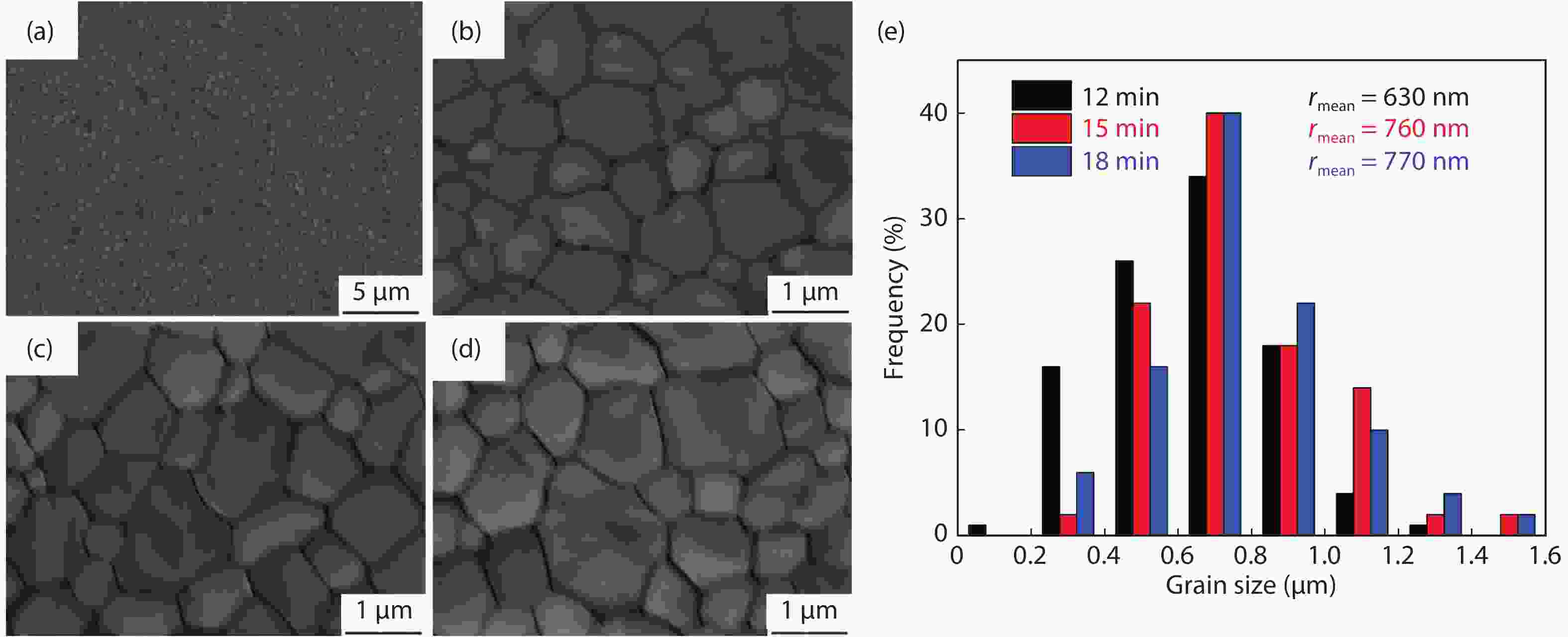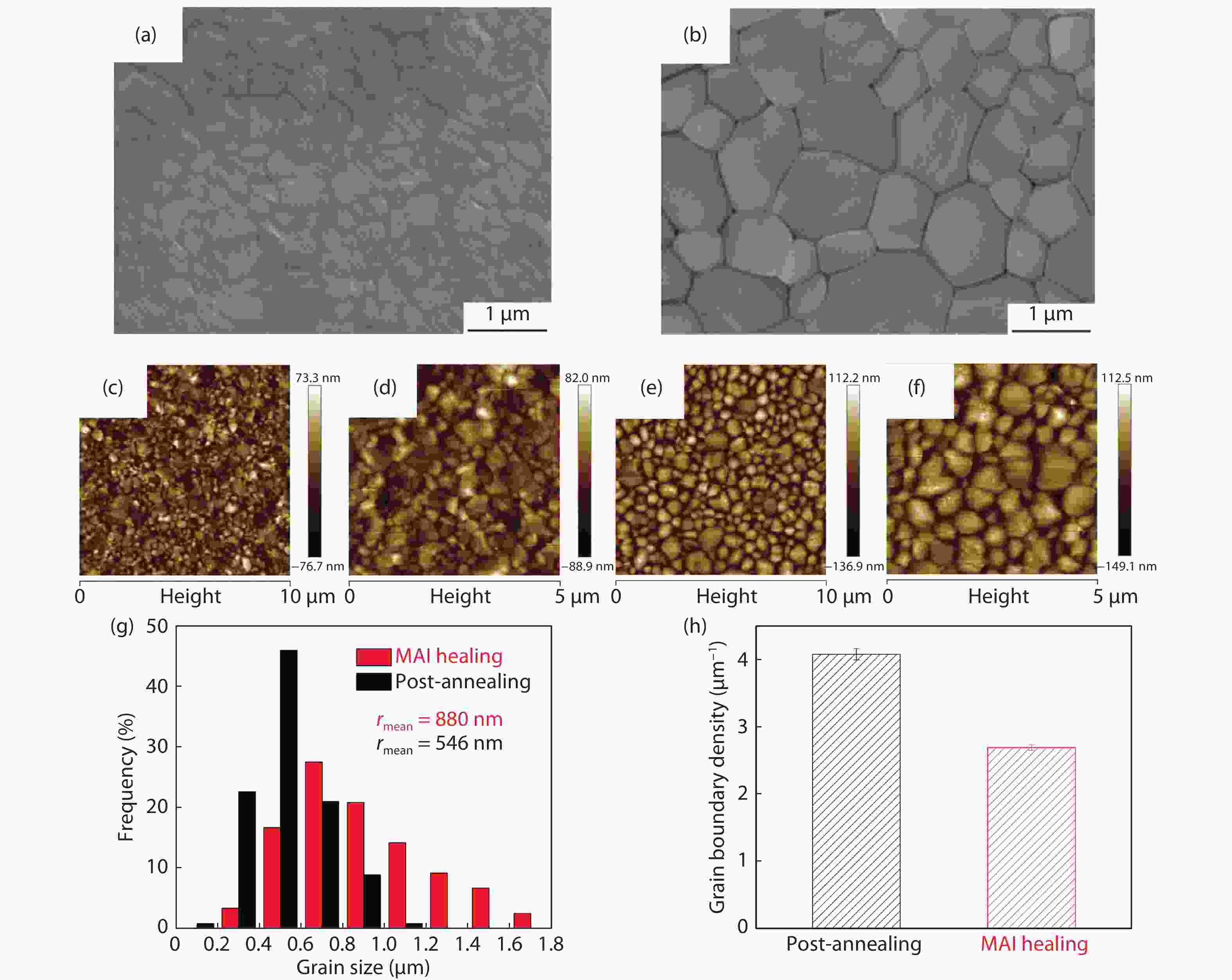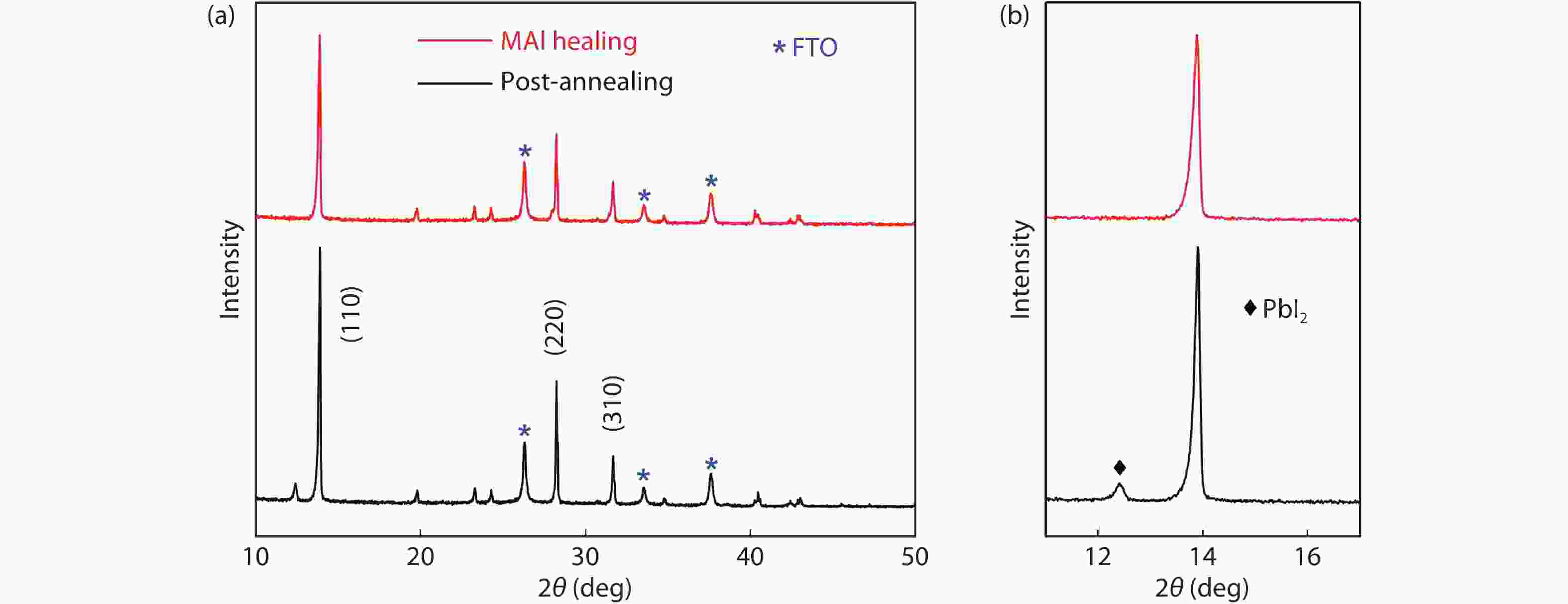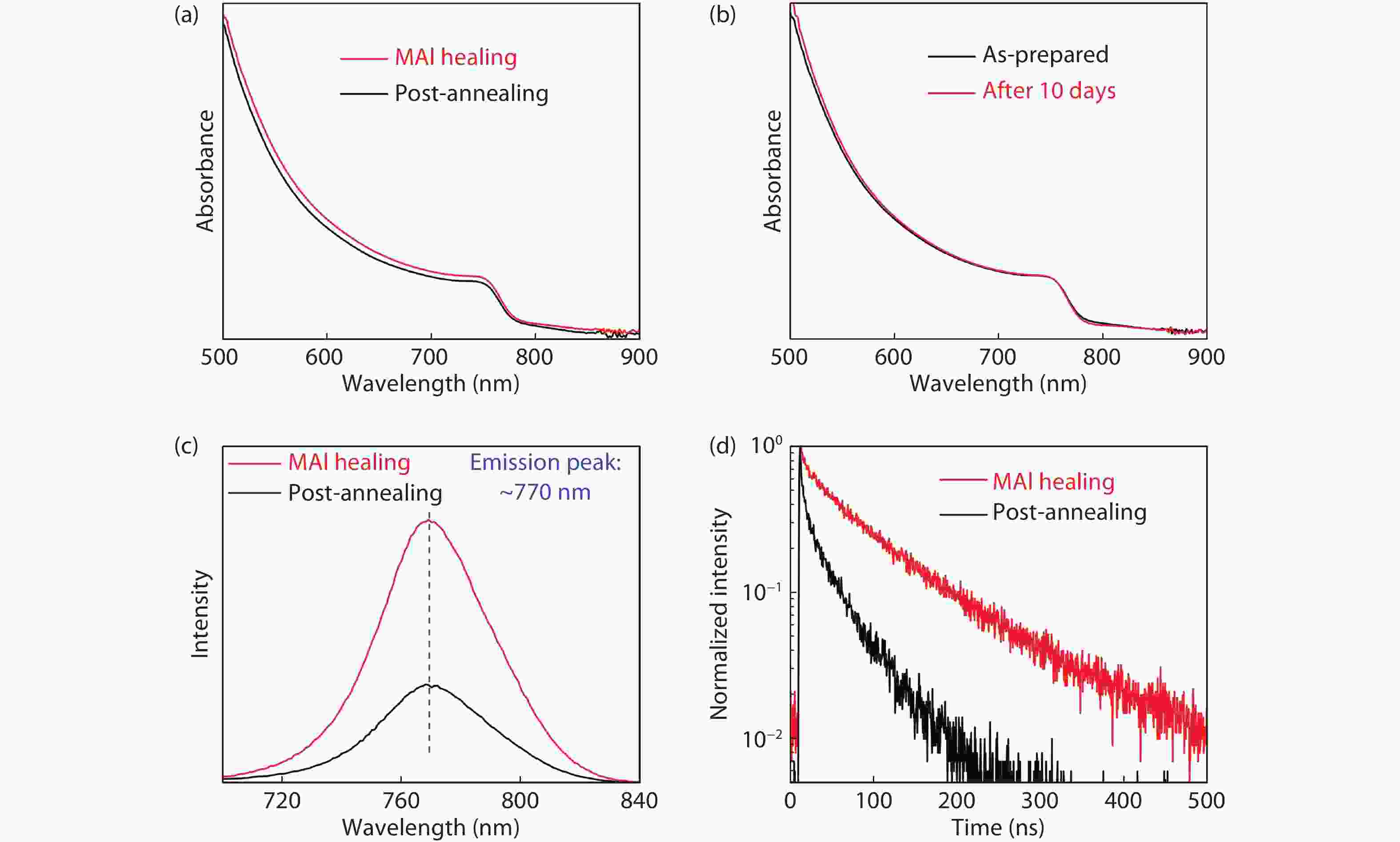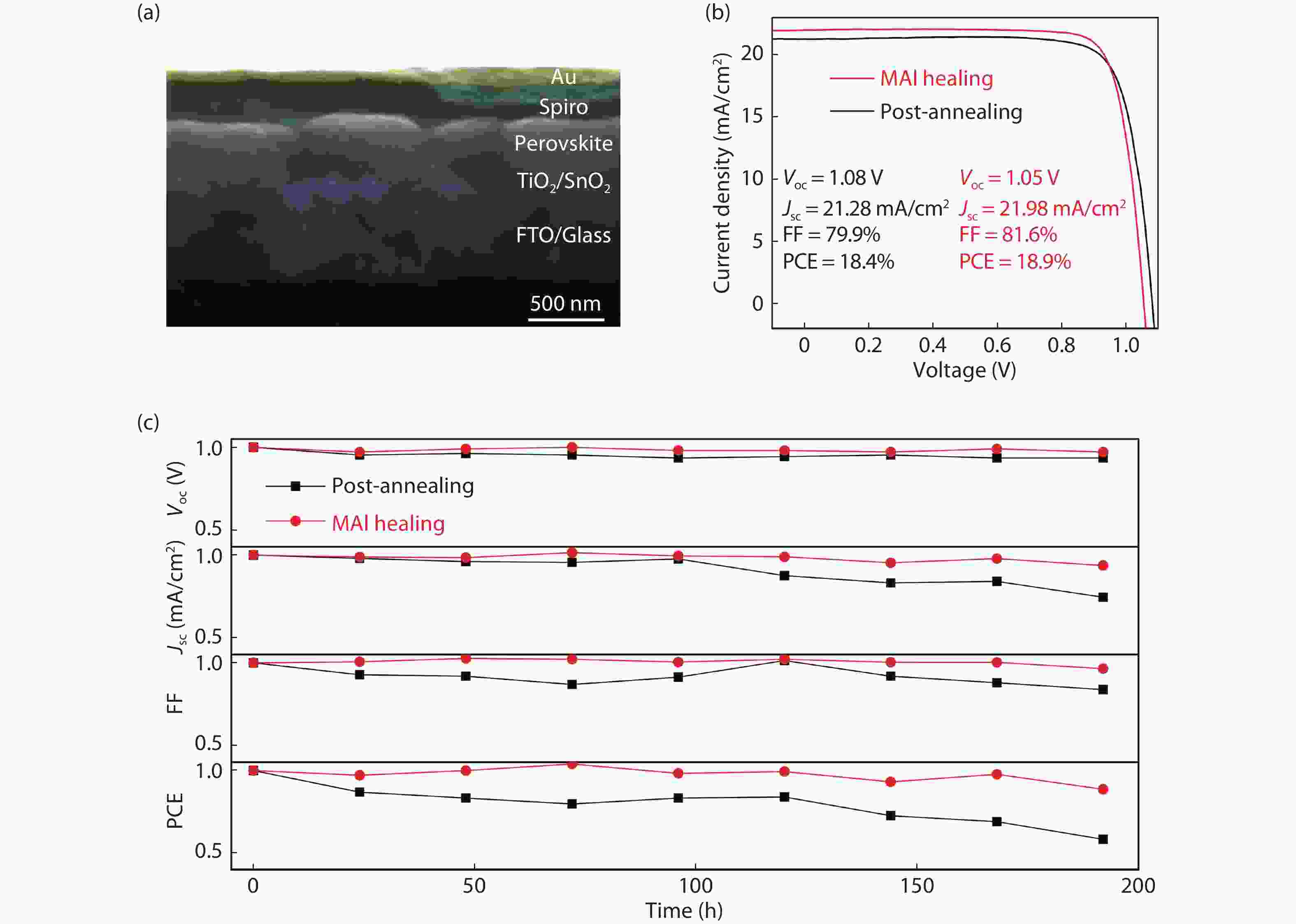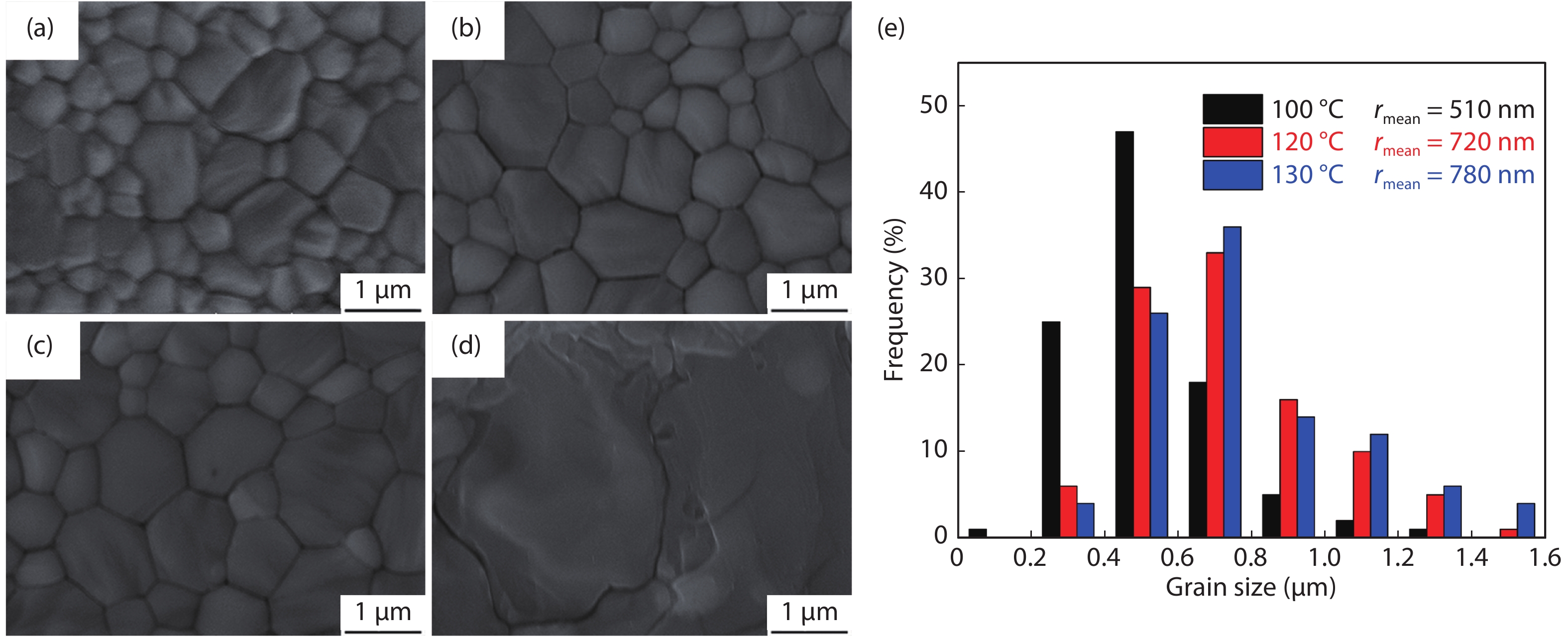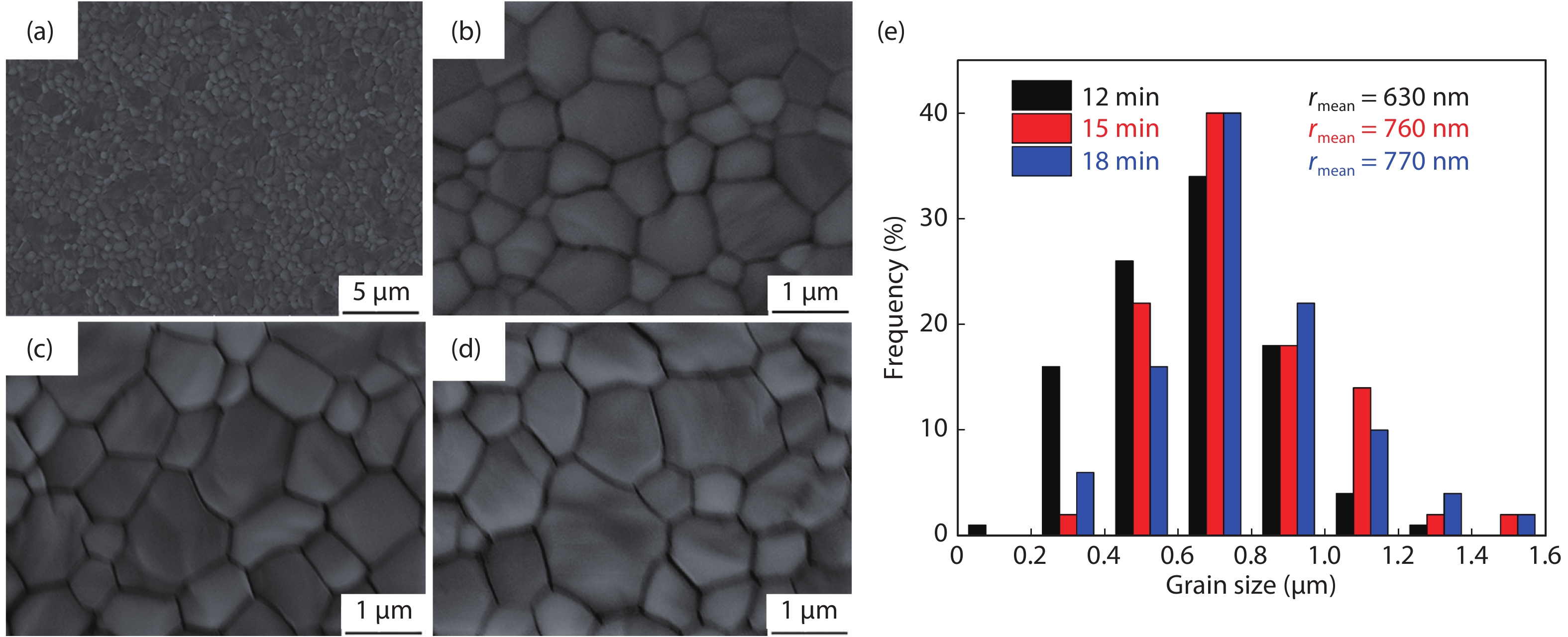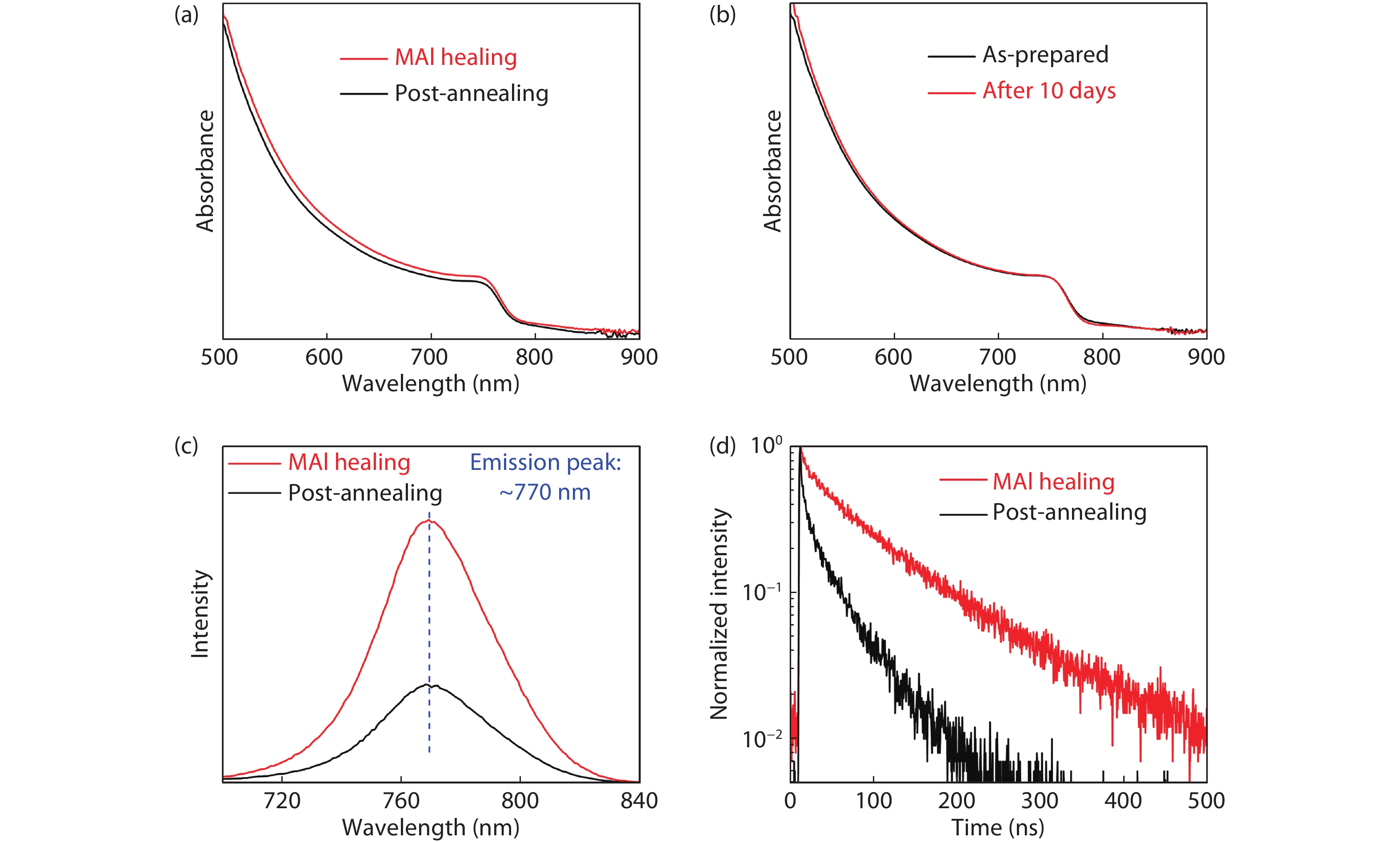| Citation: |
Zhen Li, Guanjun Yang. A methylammonium iodide healing method for CH3NH3PbI3 perovskite solar cells with high fill factor over 80%[J]. Journal of Semiconductors, 2021, 42(11): 112202. doi: 10.1088/1674-4926/42/11/112202
Z Li, G J Yang, A methylammonium iodide healing method for CH3NH3PbI3 perovskite solar cells with high fill factor over 80%[J]. J. Semicond., 2021, 42(11): 112202. doi: 10.1088/1674-4926/42/11/112202.
Export: BibTex EndNote
|
A methylammonium iodide healing method for CH3NH3PbI3 perovskite solar cells with high fill factor over 80%
doi: 10.1088/1674-4926/42/11/112202
More Information-
Abstract
Repressing the thermal decomposition during the process of heat treatment plays an indispensable part in the preparation of perovskite films. Here, a methylammonium iodide healing method was applied to prevent the volatilization of the organic component inside the perovskite structure during the heat treatment. High-quality CH3NH3PbI3 film with a much larger grain size over 800 nm was successfully fabricated via this healing method. Besides, the absorption and photoluminescence intensity were also both improved. Finally, the best power conversion efficiency of 18.89% with a fill factor over 80% was realized in an n–i–p configuration while possessing outstanding stability. This work suggests that methylammonium iodide healing method is a reliable way to promote crystal growth and improve the photovoltaic performance and humidity stability of the CH3NH3PbI3 solar cells.-
Keywords:
- perovskite,
- solar cells,
- heat treatment,
- film quality,
- photovoltaic performance,
- stability
-
References
[1] Zuo C T, Bolink H J, Han H W, et al. Advances in perovskite solar cells. Adv Sci, 2016, 3, 1500324 doi: 10.1002/advs.201500324[2] Jena A K, Kulkarni A, Miyasaka T. Halide perovskite photovoltaics: background, status, and future prospects. Chem Rev, 2019, 119, 3036 doi: 10.1021/acs.chemrev.8b00539[3] Kim J Y, Lee J W, Jung H S, et al. High-efficiency perovskite solar cells. Chem Rev, 2020, 120, 7867 doi: 10.1021/acs.chemrev.0c00107[4] Wang P, Wu Y H, Cai B, et al. Solution-processable perovskite solar cells toward commercialization: progress and challenges. Adv Funct Mater, 2019, 29, 1807661 doi: 10.1002/adfm.201807661[5] Huang F, Li M J, Siffalovic P, et al. From scalable solution fabrication of perovskite films towards commercialization of solar cells. Energy Environ Sci, 2019, 12, 518 doi: 10.1039/C8EE03025A[6] Kojima A, Teshima K, Shirai Y, et al. Organometal halide perovskites as visible-light sensitizers for photovoltaic cells. J Am Chem Soc, 2009, 131, 6050 doi: 10.1021/ja809598r[7] Jeong J, Kim M, Seo J, et al. Pseudo-halide anion engineering for α-FAPbI3 perovskite solar cells. Nature, 2021, 592, 381 doi: 10.1038/s41586-021-03406-5[8] Motti S G, Meggiolaro D, Martani S, et al. Defect activity in lead halide perovskites. Adv Mater, 2019, 31, 1901183 doi: 10.1002/adma.201901183[9] Castro-Méndez A F, Hidalgo J, Correa-Baena J P. The role of grain boundaries in perovskite solar cells. Adv Energy Mater, 2019, 9, 1901489 doi: 10.1002/aenm.201901489[10] Yang Y Q, Wu J H, Wang X B, et al. Suppressing vacancy defects and grain boundaries via ostwald ripening for high-performance and stable perovskite solar cells. Adv Mater, 2020, 32, 1904347 doi: 10.1002/adma.201904347[11] Kong W C, Wang S W, Li F, et al. Ultrathin perovskite monocrystals boost the solar cell performance. Adv Energy Mater, 2020, 10, 2000453 doi: 10.1002/aenm.202000453[12] Zuo C T, Ding L M. An 80.11% FF record achieved for perovskite solar cells by using the NH4Cl additive. Nanoscale, 2014, 6, 9935 doi: 10.1039/C4NR02425G[13] Wang S R, Wang A L, Deng X Y, et al. Lewis acid/base approach for efficacious defect passivation in perovskite solar cells. J Mater Chem A, 2020, 8, 12201 doi: 10.1039/D0TA03957H[14] Xiong S B, Hao T Y, Sun Y Y, et al. Defect passivation by nontoxic biomaterial yields 21% efficiency perovskite solar cells. J Energy Chem, 2021, 55, 265 doi: 10.1016/j.jechem.2020.06.061[15] Zhang F, Zhu K. Additive engineering for efficient and stable perovskite solar cells. Adv Energy Mater, 2020, 10, 1902579 doi: 10.1002/aenm.201902579[16] Xie L S, Cao Z Y, Wang J W, et al. Improving energy level alignment by adenine for efficient and stable perovskite solar cells. Nano Energy, 2020, 74, 104846 doi: 10.1016/j.nanoen.2020.104846[17] Chen J Z, Park N G. Materials and methods for interface engineering toward stable and efficient perovskite solar cells. ACS Energy Lett, 2020, 5, 2742 doi: 10.1021/acsenergylett.0c01240[18] Chin S H, Choi J W, Woo H C, et al. Realizing a highly luminescent perovskite thin film by controlling the grain size and crystallinity through solvent vapour annealing. Nanoscale, 2019, 11, 5861 doi: 10.1039/C8NR09947B[19] Liu B B, Wang S, Ma Z R, et al. High-performance perovskite solar cells with large grain-size obtained by the synergy of urea and dimethyl sulfoxide. Appl Surf Sci, 2019, 467/468, 708 doi: 10.1016/j.apsusc.2018.10.141[20] Kavadiya S, Strzalka J, Niedzwiedzki D M, et al. Crystal reorientation in methylammonium lead iodide perovskite thin film with thermal annealing. J Mater Chem A, 2019, 7, 12790 doi: 10.1039/C9TA02358E[21] Zuo C T, Ding L M. Drop-casting to make efficient perovskite solar cells under high humidity. Angew Chem Int Ed, 2021, 60, 1 doi: 10.1002/anie.202015604[22] Ren X D, Yang Z, Yang D, et al. Modulating crystal grain size and optoelectronic properties of perovskite films for solar cells by reaction temperature. Nanoscale, 2016, 8, 3816 doi: 10.1039/C5NR08935B[23] Boyd C C, Cheacharoen R, Leijtens T, et al. Understanding degradation mechanisms and improving stability of perovskite photovoltaics. Chem Rev, 2019, 119, 3418 doi: 10.1021/acs.chemrev.8b00336[24] Bisquert J, Juarez-Perez E J. The causes of degradation of perovskite solar cells. J Phys Chem Lett, 2019, 10, 5889 doi: 10.1021/acs.jpclett.9b00613[25] Dunfield S P, Bliss L, Zhang F, et al. From defects to degradation: a mechanistic understanding of degradation in perovskite solar cell devices and modules. Adv Energy Mater, 2020, 10, 1904054 doi: 10.1002/aenm.201904054[26] Shi B, Yao X, Hou F H, et al. Unraveling the passivation process of PbI2 to enhance the efficiency of planar perovskite solar cells. J Phys Chem C, 2018, 122, 21269 doi: 10.1021/acs.jpcc.8b08075[27] Chen Y C, Meng Q, Xiao Y Y, et al. Mechanism of PbI2 in situ passivated perovskite films for enhancing the performance of perovskite solar cells. ACS Appl Mater Interfaces, 2019, 11, 44101 doi: 10.1021/acsami.9b13648[28] Huang X J, Dong G P, Ding L M. The recovery of perovskites. Sci Bull, 2020, 65, 1600 doi: 10.1016/j.scib.2020.06.034[29] Zhou Z M, Wang Z W, Zhou Y Y, et al. Methylamine-gas-induced defect-healing behavior of CH3NH3PbI3 thin films for perovskite solar cells. Angew Chem Int Ed, 2015, 54, 9705 doi: 10.1002/anie.201504379[30] Li C W, Pang S P, Xu H X, et al. Methylamine gas based synthesis and healing process toward upscaling of perovskite solar cells: progress and perspective. Sol RRL, 2017, 1, 1700076 doi: 10.1002/solr.201700076[31] Yang G J, Chu Q Q, Ding B, et al. A preparation method of quasi-single crystal perovskite film. China patent, CN110534654A, 2019[32] Ding B, Gao L L, Liang L S, et al. Facile and scalable fabrication of highly efficient lead iodide perovskite thin-film solar cells in air using gas pump method. ACS Appl Mater Interfaces, 2016, 8, 20067 doi: 10.1021/acsami.6b05862[33] Ding B, Huang S Y, Chu Q Q, et al. Low-temperature SnO2-modified TiO2 yields record efficiency for normal planar perovskite solar modules. J Mater Chem A, 2018, 6, 10233 doi: 10.1039/C8TA01192C -
Proportional views






 DownLoad:
DownLoad:

